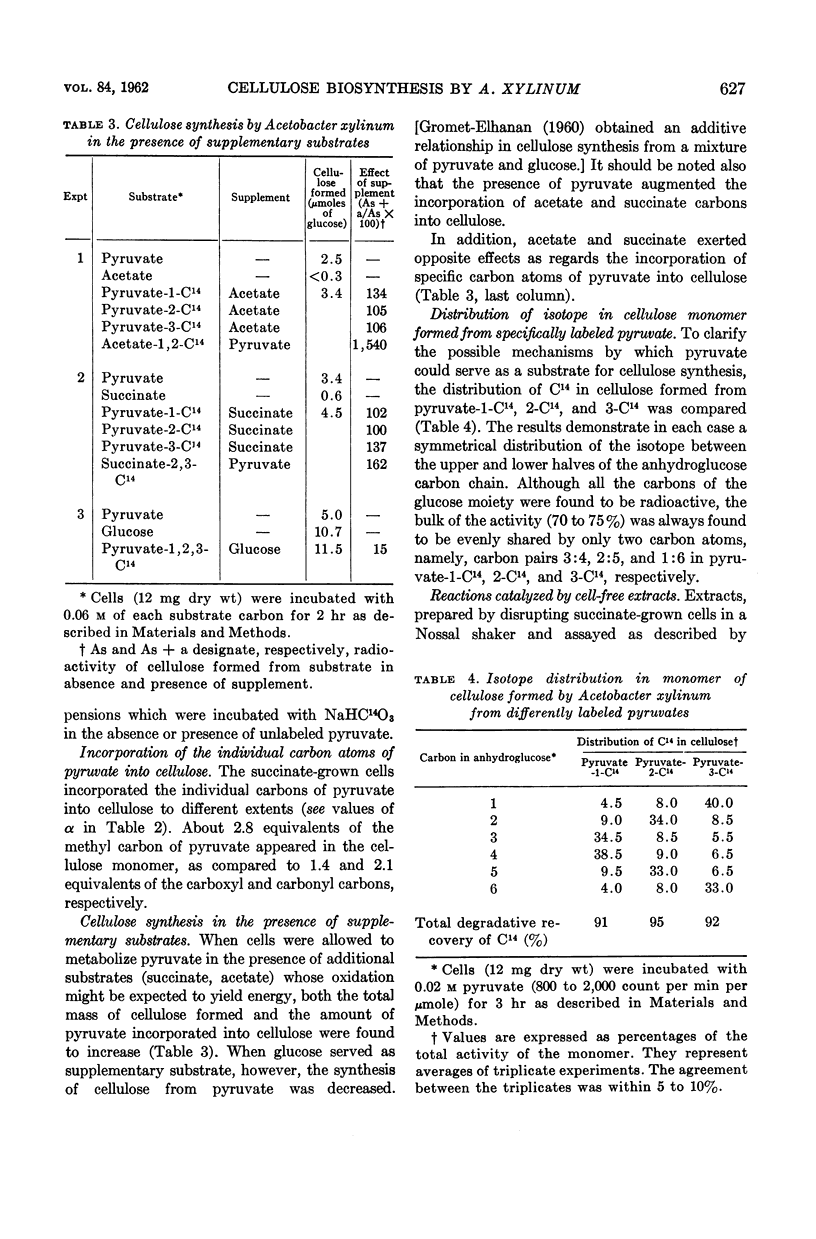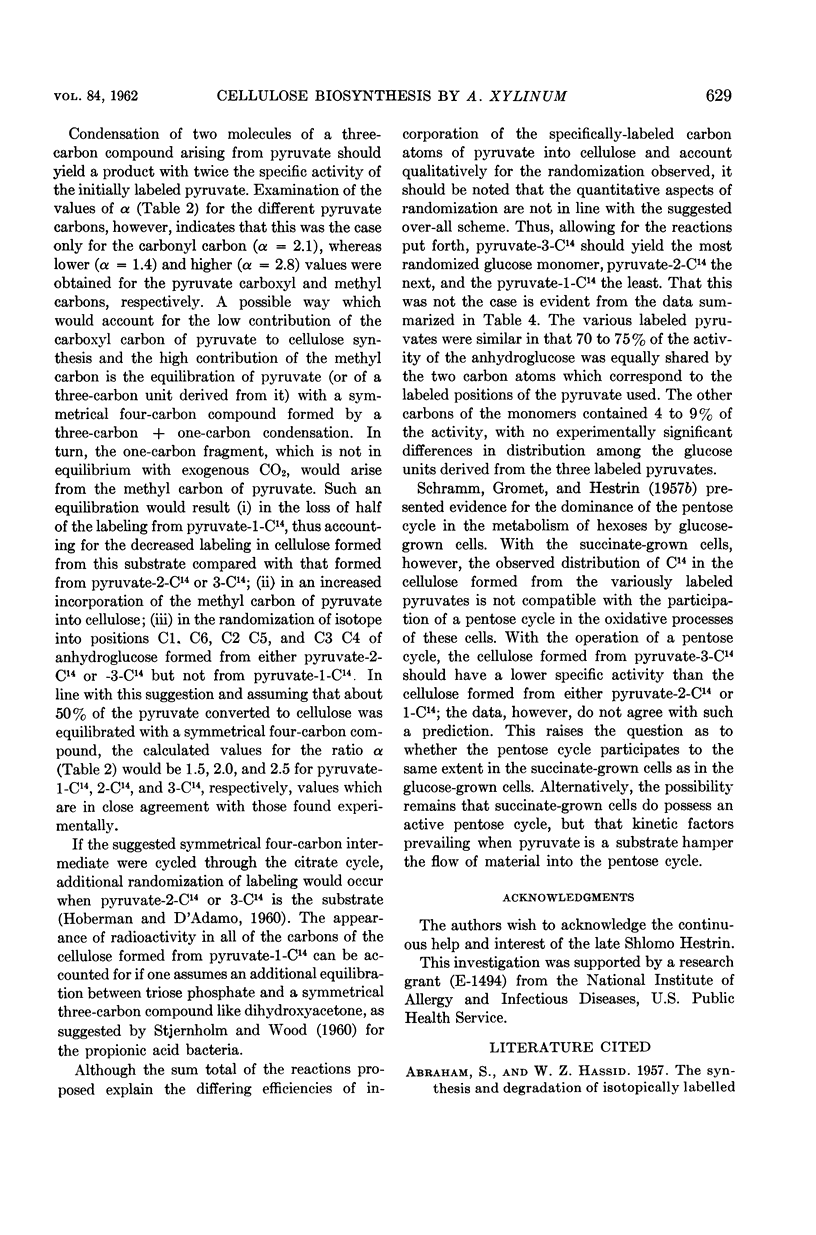Abstract
Benziman, Moshe (The Hebrew University of Jerusalem, Jerusalem, Israel) and H. Burger-Rachamimov. Synthesis of cellulose from pyruvate by succinate-grown cells of Acetobacter xylinum. J. Bacteriol. 84:625–630. 1962.—Pyruvate was converted into cellulose by succinate-grown cells of Acetobacter xylinum. With pyruvate-1-, 2-, or 3-C14 as substrate, the upper half of the cellulose monomer mirrored the lower half, both as to total content and distribution of C14. In each case, about 75% of the total radioactivity of the cellulose monomer was found in two carbon atoms (carbon pairs 3:4, 2:5, and 1:6, derived from pyruvate-1-, 2-, and 3-C14, respectively). The carbonyl carbon of pyruvate contributed 2 equivalents to the cellulose monomer, compared with 1.4 and 2.8 equivalents contributed by the pyruvate carboxyl and methyl carbons, respectively. Cellulose formed in the presence of pyruvate and C14O2 was nonradioactive. The results suggest that the carbon chain of the cellulose monomer is formed in these cells via a condensation involving two molecules of a three-carbon compound. Reactions involving pyruvate which could account for the observed distribution of C14 in cellulose are discussed.
Full text
PDF





Selected References
These references are in PubMed. This may not be the complete list of references from this article.
- ATKINSON D. E. The oxidation of ethanol and tricarboxylic acid cycle intermediates by Acetobacter peroxydans. J Bacteriol. 1956 Aug;72(2):195–198. doi: 10.1128/jb.72.2.195-198.1956. [DOI] [PMC free article] [PubMed] [Google Scholar]
- CHELDELIN V. H., KAWASAKI E. H., KING T. E. Tricarboxylic acid cycle activity in Acetobacter pasteurianum. J Bacteriol. 1956 Sep;72(3):418–421. doi: 10.1128/jb.72.3.418-421.1956. [DOI] [PMC free article] [PubMed] [Google Scholar]
- DICKENS F., WILLIAMSON D. H. Studies on the metabolism of hydroxypyruvate in animal tissues. Biochem J. 1959 Jul;72:496–508. doi: 10.1042/bj0720496. [DOI] [PMC free article] [PubMed] [Google Scholar]
- EDELMAN J., GINSBURG V., HASSID W. Z. Conversion of monosaccharides to sucrose and cellulose in wheat seedlings. J Biol Chem. 1955 Apr;213(2):843–854. [PubMed] [Google Scholar]
- GROMET Z., SCHRAMM M., HESTRIN S. Synthesis of cellulose by Acetobacter Xylinum. 4. Enzyme systems present in a crude extract of glucose-grown cells. Biochem J. 1957 Dec;67(4):679–689. doi: 10.1042/bj0670679. [DOI] [PMC free article] [PubMed] [Google Scholar]
- HIATT H. H., GOLDSTEIN M., LAREAU J., HORECKER B. L. The pathway of hexose synthesis from pyruvate in muscle. J Biol Chem. 1958 Mar;231(1):303–307. [PubMed] [Google Scholar]
- HOBERMAN H. D., D'ADAMO A. F., Jr Coupling of oxidation of substrates to reductive biosyntheses. III. Studies with L- and D-lactates. J Biol Chem. 1960 Feb;235:514–518. [PubMed] [Google Scholar]
- KREBS H. A. Considerations concerning the pathways of syntheses in living matter; synthesis of glycogen from non-carbohydrate precursors. Bull Johns Hopkins Hosp. 1954 Jul;95(1):19–33. [PubMed] [Google Scholar]
- KRIMSKY I. Enzymatic formation of high levels of 1,3-diphosphoglycerate from 3-phosphoglycerate; isolation and further metabolism. J Biol Chem. 1959 Feb;234(2):228–231. [PubMed] [Google Scholar]
- KRIMSKY I. Phosphorylation of pyruvate by the pyruvate kinase reaction and reversal of glycolysis in a reconstructed system. J Biol Chem. 1959 Feb;234(2):232–236. [PubMed] [Google Scholar]
- Robertson W. V. THE PREPARATION OF SODIUM PYRUVATE. Science. 1942 Jul 24;96(2482):93–94. doi: 10.1126/science.96.2482.93. [DOI] [PubMed] [Google Scholar]
- SCHRAMM M., GROMET Z., HESTRIN S. Synthesis of cellulose by Acetobacter Xylinum. 3. Substrates and inhibitors. Biochem J. 1957 Dec;67(4):669–679. doi: 10.1042/bj0670669. [DOI] [PMC free article] [PubMed] [Google Scholar]
- SCHRAMM M., HESTRIN S. Synthesis of cellulose by Acetobacter xylinum. I. Micromethod for the determination of celluloses. Biochem J. 1954 Jan;56(1):163–166. doi: 10.1042/bj0560163. [DOI] [PMC free article] [PubMed] [Google Scholar]
- TANENBAUM S. W. The metabolism of Acetobacter peroxidans. I. Oxidative enzymes. Biochim Biophys Acta. 1956 Aug;21(2):335–342. doi: 10.1016/0006-3002(56)90017-8. [DOI] [PubMed] [Google Scholar]
- UTTER M. F., KEECH D. B. Formation of oxaloacetate from pyruvate and carbon dioxide. J Biol Chem. 1960 May;235:PC17–PC18. [PubMed] [Google Scholar]
- UTTER M. F., KURAHASHI K. Mechanism of action of oxalacetic carboxylase. J Biol Chem. 1954 Apr;207(2):821–841. [PubMed] [Google Scholar]
- WEINMAN E. O., STRISOWER E. H., CHAIKOFF I. L. Conversion of fatty acids to carbohydrate; application of isotopes to this problem and role of the Krebs cycle as a synthetic pathway. Physiol Rev. 1957 Apr;37(2):252–272. doi: 10.1152/physrev.1957.37.2.252. [DOI] [PubMed] [Google Scholar]


